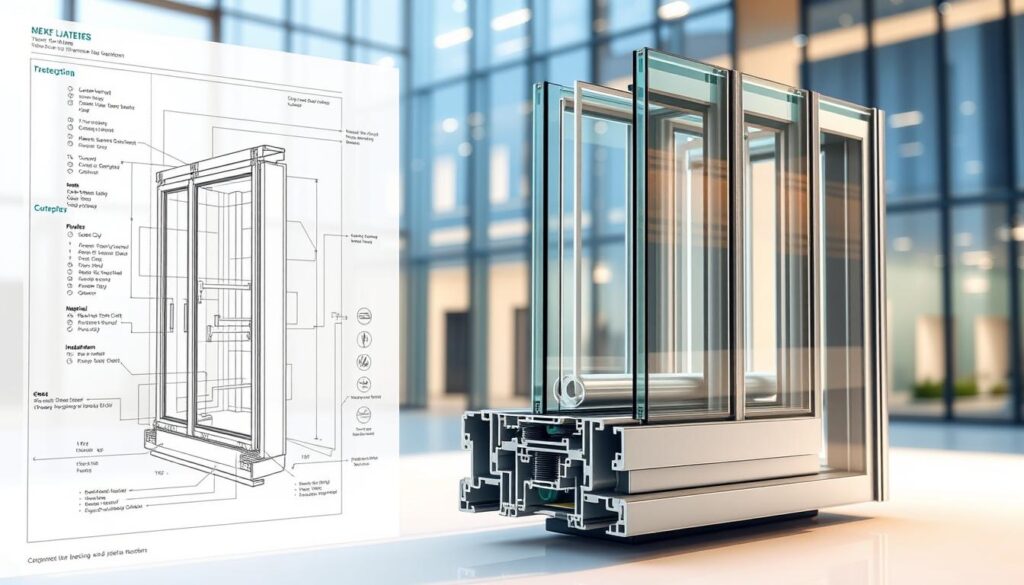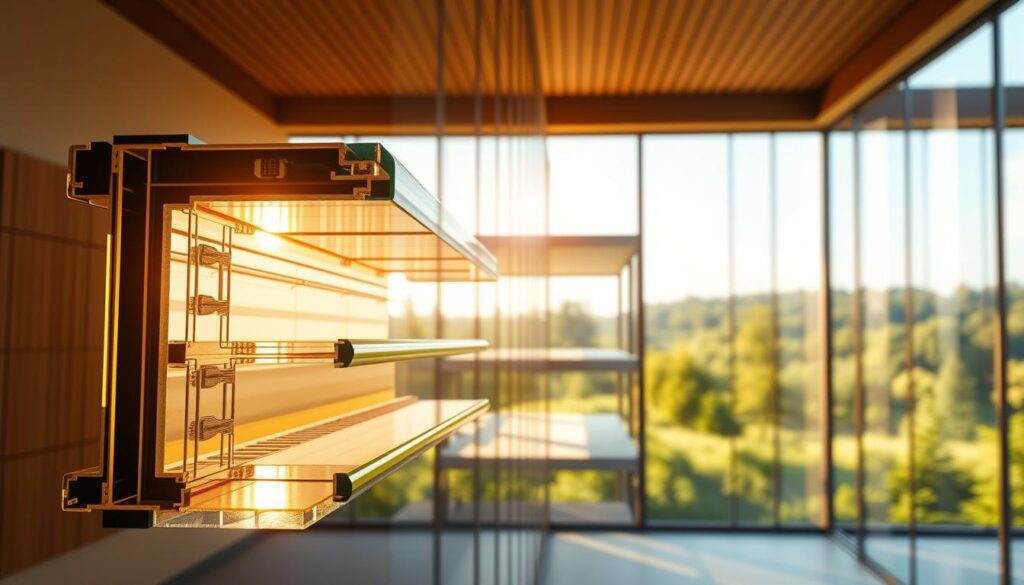Can a building’s facade be both aesthetically stunning and highly functional? The answer lies in glazing engineering, a critical aspect of modern architecture that combines design and functionality.
Glazing design plays a pivotal role in enhancing the energy efficiency, safety, and visual appeal of buildings. As architects and designers, understanding the principles of glazing engineering is essential for creating structures that are not only visually striking but also sustainable and durable.
This guide will walk you through the fundamentals of glazing engineering, its applications, and best practices, providing a comprehensive understanding of this complex field.
Key Takeaways
- Understanding the basics of glazing engineering and its importance in modern architecture.
- Learning how glazing design impacts energy efficiency and building safety.
- Gaining insights into the applications of glazing engineering in various construction projects.
- Discovering best practices for mastering glazing engineering.
- Exploring the future trends in glazing engineering and their implications.
Understanding Glazing Engineering
Glazing engineering combines technical expertise with architectural vision to create buildings that are both sustainable and visually striking. This field has become increasingly important in modern construction, where the balance between energy efficiency and aesthetic appeal is crucial.
Definition and Importance
Glazing engineering refers to the design and installation of glass facades and other glazing systems in buildings. It is a critical aspect of modern architecture, as it directly impacts the energy efficiency, safety, and aesthetic appeal of a structure. A well-designed glazing system can significantly reduce a building’s energy consumption by minimizing heat transfer and maximizing natural light.
The importance of glazing engineering lies in its ability to enhance the overall performance of a building. By selecting the appropriate glazing materials and systems, architects and engineers can create buildings that are not only visually appealing but also environmentally friendly.
Key Components of Glazing Engineering
The key components of glazing engineering include the selection of appropriate glazing materials, the design of the glazing system, and the installation process. Curtain wall systems, for instance, are a popular choice for modern commercial buildings due to their aesthetic appeal and structural integrity. These systems consist of a network of aluminum or steel frames filled with glass or other materials, providing a seamless exterior envelope.
Other critical components include the type of glass used, such as double-glazed or triple-glazed units, and the framing materials, which can significantly impact the thermal performance of the building. Advanced coatings and treatments can also be applied to the glass to enhance its energy efficiency and reduce glare.
Applications in Modern Architecture
In modern architecture, glazing engineering is applied in various ways to create innovative and sustainable buildings. Glazing systems are used not only for exterior facades but also for interior partitions and roofs, providing natural light and reducing the need for artificial lighting.
The use of architectural glazing in modern architecture has led to the creation of iconic buildings that are both functional and visually stunning. By pushing the boundaries of glazing engineering, architects can design buildings that are not only sustainable but also serve as landmarks in urban landscapes.
Types of Glazing Systems

The world of glazing engineering encompasses various types of glazing systems, each designed to meet specific architectural needs. Glazing systems play a crucial role in building design, impacting energy efficiency, aesthetics, and structural integrity.
Single Glazing vs. Double Glazing
Single glazing involves a single pane of glass, which, while simple and cost-effective, offers limited insulation. In contrast, double glazing consists of two glass panes separated by a gap, significantly improving thermal insulation and reducing energy consumption. For instance, a study on energy-efficient glazing highlights the benefits of double glazing in minimizing heat transfer.
- Single glazing: Simple, cost-effective, but limited insulation.
- Double glazing: Improved thermal insulation, reduced energy consumption.
Triple Glazing and Its Benefits
Triple glazing takes the concept of double glazing a step further by incorporating three panes of glass. This advanced glazing solution offers even greater energy efficiency, making it ideal for buildings in extreme climates or those designed with sustainability in mind. The additional pane reduces heat transfer and noise pollution, enhancing occupant comfort.
“Triple glazing is a game-changer for energy efficiency in buildings, offering unparalleled insulation and comfort.”
Specialized Glazing Solutions
Beyond traditional glazing options, structural glazing and other specialized solutions are gaining popularity. Structural glazing involves bonding glass to the building frame using high-strength adhesives, creating a sleek, modern appearance. For more information on different types of structural glazing, visit structural glazing solutions.
These glazing solutions not only enhance the aesthetic appeal of buildings but also provide unique functional benefits, such as improved durability and weather resistance.
- Structural glazing for a modern, sleek appearance.
- Specialized coatings for enhanced performance.
The Role of Materials in Glazing Engineering
In the realm of glazing engineering, materials play a pivotal role in determining the aesthetic, functional, and environmental attributes of glazing systems. The choice of materials can significantly influence energy efficiency, sustainability, and the overall performance of buildings.
Common Glazing Materials
Glazing materials vary widely, each with its unique properties and applications. Common materials include float glass, tempered glass, laminated glass, and insulated glass units (IGUs). Float glass is the most basic form, known for its clarity and smoothness. Tempered glass, on the other hand, is processed to enhance its strength and durability, making it suitable for safety-critical applications.
Laminated glass consists of multiple layers bonded together, offering enhanced security and sound insulation. IGUs are composed of two or more glass panes separated by a gap, significantly improving thermal insulation.
“The selection of glazing materials is not just about aesthetics; it’s also about functionality, energy efficiency, and sustainability.” –
| Material | Properties | Applications |
|---|---|---|
| Float Glass | Clarity, Smoothness | General glazing, Windows |
| Tempered Glass | Strength, Durability | Safety-critical applications, Shower doors |
| Laminated Glass | Security, Sound insulation | Security glazing, Soundproofing |
| Insulated Glass Units (IGUs) | Thermal insulation | Energy-efficient glazing, Commercial buildings |
Advanced Coatings and Treatments
Advanced coatings and treatments have revolutionized glazing engineering by enhancing the performance of glazing materials. Low-e coatings, for instance, minimize heat transfer, reducing energy consumption. Other treatments include tinting, which can reduce solar gain, and reflective coatings that minimize glare.
Low-e coatings are particularly noteworthy for their ability to reflect radiant heat while allowing visible light to pass through, significantly improving energy efficiency.
Sustainability in Glazing Materials
Sustainability is becoming increasingly important in glazing engineering. Materials and manufacturing processes are being developed to minimize environmental impact. Recycled glass content, for example, can reduce the need for raw materials. Additionally, glazing systems that maximize natural light and reduce the need for artificial lighting contribute to energy efficiency and sustainability.
The use of sustainable glazing materials not only reduces environmental footprint but also enhances the overall building performance and occupant comfort.
The Design Process for Glazing Systems

Creating an effective glazing system involves a comprehensive design process that balances functionality and aesthetics. This process is crucial in architectural glazing projects, where the glazing design not only affects the building’s appearance but also its energy efficiency and overall performance.
Initial Planning and Conceptualization
The initial stage of the glazing design process involves thorough planning and conceptualization. This includes understanding the project’s requirements, such as the building’s purpose, location, and environmental conditions. According to
“The design process for glazing systems is a critical component of modern architectural projects, requiring a blend of technical expertise and creative vision.”
It’s essential to collaborate with architects, engineers, and clients to ensure that all aspects are considered.
During this phase, designers also explore various glazing materials and technologies, such as double or triple glazing, to determine the most suitable options for the project. For more insights on custom glazing systems, visit Bellwether Design Tech.
Structural Considerations
Structural considerations play a vital role in the glazing design process. The glazing system must be able to withstand various environmental stresses, including wind pressure, thermal stress, and potential impact loads. As noted by industry experts,
“A well-designed glazing system is not just about aesthetics; it’s also about ensuring the structural integrity of the building.”
This requires careful calculation and simulation to ensure that the glazing system meets all necessary safety and performance standards.
For detailed information on the engineering design process, refer to World Civil Society, which provides valuable insights into the structural considerations involved in glazing engineering.
Aesthetic Design Choices
Aesthetic considerations are equally important in the glazing design process. The glazing system can significantly impact the visual appeal of a building, influencing its overall architectural style and character. Designers must balance factors such as transparency, reflectivity, and color to achieve the desired aesthetic effect.
By integrating advanced glazing technologies, such as smart glazing or decorative glazing, designers can create unique and visually striking effects that enhance the building’s appearance. The choice of glazing design can also affect the building’s interaction with natural light, further influencing its aesthetic and functional qualities.
Installation Techniques for Glazing Systems
Proper installation of glazing systems is essential to ensure the safety, durability, and energy efficiency of buildings. The process involves several critical steps, from preparation to final inspection.
Standard Installation Processes
The standard installation process for glazing systems typically begins with a thorough site assessment and preparation. This includes:
- Reviewing project specifications and blueprints
- Inspecting the site for any potential hazards or obstacles
- Preparing the necessary tools and equipment
Key steps in the installation process include framing, glazing unit placement, sealing, and final inspection. Each step requires precision to ensure the overall performance of the glazing system.
Common Challenges and Solutions
Despite careful planning, glazing installation can present several challenges, such as:
- Weather conditions affecting the installation process
- Misfit or damaged glazing units
- Inadequate sealing or framing issues
To address these challenges, installers can take several measures, including:
- Using weather-resistant materials and techniques
- Conducting thorough inspections of glazing units before installation
- Ensuring proper sealing and framing techniques are employed
Tools and Equipment for Installation
The right tools and equipment are crucial for a successful glazing installation. Some of the essential tools include:
- Glazing knives and breakers
- Suction cups for handling large glazing units
- Sealant guns and backer rods
Investing in high-quality tools can improve efficiency and reduce the risk of errors during the installation process.
Building Codes and Standards

Compliance with building codes and standards is essential for the successful design and installation of glazing systems. These regulations ensure that glazing solutions are safe, efficient, and environmentally friendly.
Overview of Relevant Building Codes
Building codes vary by jurisdiction but generally cover aspects such as structural integrity, fire safety, and energy efficiency. For instance, in the United States, the 2022 Construction Codes provide a comprehensive framework for construction practices, including glazing.
Some key considerations in building codes include:
- Minimum requirements for glazing materials and installation methods
- Standards for safety glazing in hazardous locations
- Regulations regarding energy efficiency and thermal performance
Safety Standards in Glazing Engineering
Safety standards are critical in glazing engineering to prevent injuries and fatalities. These standards often mandate the use of safety glazing in certain applications, such as:
- Glazing in doors and sidelights
- Glazing in bathrooms and showers
- Glazing near stairways and landings
Safety glazing typically involves the use of tempered glass, laminated glass, or other approved materials that are designed to minimize the risk of breakage and injury.
Environmental Regulations Impacting Glazing
Environmental regulations are increasingly influencing glazing engineering, with a focus on sustainability and energy efficiency. These regulations may include:
- Standards for energy-efficient glazing solutions
- Requirements for the use of environmentally friendly materials
- Guidelines for reducing the environmental impact of glazing systems throughout their lifecycle
By adhering to these regulations, glazing engineers can contribute to the development of more sustainable buildings.
Performance Testing in Glazing Engineering
Performance testing is a critical component in glazing engineering, ensuring that glazing systems meet the required standards for safety, efficiency, and durability. This process involves a series of evaluations to assess the glazing system’s ability to withstand various environmental conditions and perform as expected.
Types of Performance Tests
There are several types of performance tests conducted on glazing systems, each designed to evaluate specific aspects of their performance. These include:
- Structural Integrity Tests: These tests assess the glazing system’s ability to withstand wind loads, impacts, and other structural stresses.
- Thermal Performance Tests: Evaluating how well the glazing system manages heat transfer, these tests are crucial for determining energy efficiency.
- Acoustic Performance Tests: These tests measure the glazing system’s ability to reduce noise transmission, enhancing the comfort of building occupants.
- Weather Resistance Tests: Assessing the glazing system’s durability against various weather conditions, including UV exposure, rain, and extreme temperatures.
Rating Systems for Glazing Products
To standardize the evaluation of glazing products, various rating systems have been established. These systems provide a framework for comparing the performance of different glazing solutions. Some of the key rating systems include:
- U-Factor Rating: Measures the glazing system’s thermal transmittance, indicating its energy efficiency.
- Solar Heat Gain Coefficient (SHGC): This rating indicates the glazing system’s ability to block heat from the sun, impacting the building’s cooling needs.
- Visible Light Transmittance (VT): Measures the amount of visible light that passes through the glazing system, affecting the building’s lighting requirements.
Interpreting Test Results
Understanding the results of performance tests is crucial for ensuring that glazing systems meet the necessary standards and perform as expected. Test results provide valuable insights into the glazing system’s strengths and weaknesses, guiding design improvements and material selections.
By carefully interpreting test results, architects, engineers, and builders can make informed decisions about glazing systems, optimizing their performance, safety, and efficiency.
Energy Efficiency in Glazing Engineering

Energy efficiency is a critical aspect of modern glazing engineering, influencing both environmental sustainability and economic viability. As buildings account for a significant portion of global energy consumption, the role of glazing in energy efficiency has become increasingly important.
Understanding Thermal Performance
Thermal performance is a key factor in energy-efficient glazing. It refers to the ability of glazing systems to minimize heat transfer between the interior and exterior of a building. Double glazing and triple glazing are examples of technologies used to enhance thermal performance by reducing heat loss in winter and heat gain in summer.
- Double glazing involves two glass panes separated by a gap, typically filled with an inert gas like argon or krypton, which reduces conductivity.
- Triple glazing adds an additional pane, further improving thermal insulation.
Impact on Energy Consumption
The impact of energy-efficient glazing on energy consumption is significant. By reducing the need for heating and cooling, energy-efficient glazing systems can lower a building’s overall energy consumption. This not only reduces energy costs but also decreases the building’s carbon footprint.
Studies have shown that buildings with energy-efficient glazing can achieve energy savings of up to 30% compared to those with traditional glazing systems.
Benefits of Energy-Efficient Glazing
The benefits of energy-efficient glazing extend beyond energy savings. These include:
- Improved Comfort: Energy-efficient glazing helps maintain a consistent indoor temperature, enhancing occupant comfort.
- Reduced Condensation: Advanced glazing technologies can minimize condensation, reducing the risk of mold and moisture damage.
- Enhanced Sustainability: By lowering energy consumption, energy-efficient glazing contributes to a building’s sustainability credentials.
In conclusion, energy-efficient glazing is a vital component of modern glazing engineering, offering numerous benefits that impact both the environment and building occupants.
Advances in Glazing Technology
Recent years have seen significant innovations in glazing technology, enhancing both functionality and sustainability. The glazing industry is continually evolving, driven by the need for energy efficiency, user comfort, and aesthetic appeal.
Smart Glazing Solutions
Smart glazing solutions represent a significant leap forward in glazing technology. These systems can change their tint or transparency in response to environmental conditions, thereby controlling the amount of light and heat that enters a building. Smart glazing can be integrated with building management systems to optimize energy consumption and enhance occupant comfort.
For instance, electrochromic glazing can switch from clear to tinted, reducing the need for blinds or shades. This technology not only improves energy efficiency but also provides users with greater control over their environment. According to a study on innovations in glass and glazing technology, such smart solutions are expected to become more prevalent in the next five years.
Innovations in Installation Techniques
Advances in installation techniques have also played a crucial role in the evolution of glazing technology. New methods and tools have improved the efficiency and safety of glazing installations. For example, the use of pre-fabricated glazing units can reduce on-site labor and minimize the risk of installation errors.
| Innovation | Description | Benefit |
|---|---|---|
| Pre-fabricated Glazing Units | Glazing units assembled off-site | Reduced installation time and errors |
| Advanced Adhesives | New adhesive technologies for stronger bonds | Improved durability and safety |
| Robotic Installation Systems | Use of robotics for precise installation | Enhanced precision and reduced labor costs |
Future Trends in Glazing Engineering
Looking ahead, future trends in glazing engineering are likely to be shaped by ongoing advancements in material science and technology. Nanotechnology and building information modeling (BIM) are expected to play significant roles in the development of next-generation glazing solutions.
As the industry continues to innovate, we can expect to see glazing systems that are not only more energy-efficient and sustainable but also more integrated with the overall building design. The future of glazing engineering holds much promise, with potential breakthroughs in areas such as self-cleaning glazing and integrated photovoltaic cells.
Glazing Engineering for Sustainability

Glazing engineering is at the forefront of sustainable building design, offering innovative solutions to minimize energy consumption and enhance occupant comfort. As buildings account for a significant portion of global energy use and greenhouse gas emissions, the role of glazing in achieving sustainability goals cannot be overstated.
The Role of Glazing in Green Buildings
Glazing plays a critical role in green buildings by controlling the amount of sunlight and heat that enters a building, thereby reducing the need for artificial lighting and heating or cooling. Energy-efficient glazing solutions can significantly lower energy consumption, making buildings more sustainable and cost-effective to operate.
Some key benefits of glazing in green buildings include:
- Reduced energy consumption through minimized heat transfer and maximized natural lighting
- Enhanced occupant comfort through controlled indoor climates and reduced glare
- Increased property value through the incorporation of sustainable design elements
Certifications for Sustainable Glazing Solutions
Various certifications recognize sustainable glazing solutions for their environmental benefits and performance. For instance, the use of photovoltaic glazing can contribute to a building’s energy efficiency and sustainability credentials.
Some notable certifications include:
- LEED (Leadership in Energy and Environmental Design) certification, which recognizes buildings that meet rigorous standards for energy efficiency and environmental sustainability
- Energy Star rating, which identifies products and buildings that offer superior energy efficiency
Case Studies in Sustainable Glazing
Several case studies demonstrate the effectiveness of sustainable glazing solutions in real-world applications. For example, a commercial building in a temperate climate might use double-glazed windows with low-E coatings to reduce heat loss in winter and heat gain in summer, resulting in significant energy savings.
These case studies highlight the potential for glazing engineering to contribute to more sustainable and energy-efficient buildings, underscoring the importance of continued innovation in this field.
Challenges in Glazing Engineering
The field of glazing engineering is not without its obstacles, as it navigates complex design, installation, and environmental issues. Despite advancements in technology and materials, glazing engineers face a multitude of challenges that can impact the performance, sustainability, and cost-effectiveness of glazing systems.
Common Design and Installation Challenges
Design and installation are critical phases in glazing engineering, and several challenges can arise during these stages. Ensuring structural integrity while achieving desired aesthetic and functional outcomes can be complex. For instance, large glazing systems require careful consideration of wind loads, seismic activity, and thermal expansion to prevent damage or failure.
Installation challenges often involve logistical and technical issues, such as coordinating with other trades, managing site conditions, and ensuring that the glazing system is properly sealed and insulated. Mistakes during installation can lead to significant problems, including water infiltration, air leakage, and reduced energy efficiency.
Environmental Impacts of Glazing Systems
Glazing systems have significant environmental impacts throughout their lifecycle, from production to disposal. The extraction and processing of raw materials, manufacturing processes, and transportation contribute to the carbon footprint of glazing products. Additionally, the energy performance of glazing systems affects a building’s overall energy consumption and greenhouse gas emissions.
To mitigate these impacts, the industry is shifting towards sustainable glazing solutions, such as using recycled materials, improving energy efficiency, and designing for recyclability and reuse at the end of the product’s life.
Economic Considerations
Economic factors play a crucial role in glazing engineering, influencing both the initial cost and the long-term value of glazing systems. The choice of glazing materials, design complexity, and installation methods all impact the upfront costs. Moreover, the energy efficiency of glazing systems can significantly affect a building’s operating costs over its lifetime.
Balancing initial costs with long-term savings is a key challenge in glazing engineering. While high-performance glazing systems may have higher upfront costs, they can offer substantial energy savings and reduced maintenance costs over time, making them a valuable investment for building owners.
Working with Stakeholders in Glazing Projects

The success of glazing projects heavily relies on the collaboration between architects, engineers, clients, and suppliers. Effective stakeholder collaboration ensures that all aspects of the project are well-coordinated, leading to successful project outcomes.
Collaboration with Architects and Engineers
Architects and engineers play a crucial role in glazing projects. Their input is vital in designing glazing systems that meet both aesthetic and structural requirements. Close collaboration with these professionals helps in identifying potential design flaws early on, thereby reducing costly revisions later in the project.
For instance, architects can provide insights into the aesthetic design choices, while engineers can focus on the structural integrity of the glazing system. This collaborative approach ensures that the glazing system is both visually appealing and structurally sound.
Engaging with Clients and End-Users
Engaging with clients and end-users is another critical aspect of stakeholder collaboration in glazing projects. Understanding their needs and expectations helps in delivering glazing solutions that meet their requirements. Regular communication with clients ensures that their vision is translated into the final product.
Moreover, involving clients in the decision-making process fosters a sense of ownership and satisfaction with the final outcome. It’s also essential to educate clients about the benefits and limitations of different glazing solutions to manage their expectations effectively.
Managing Supplier Relationships
Suppliers are vital stakeholders in glazing projects, providing the necessary materials and components. Managing supplier relationships effectively is crucial for ensuring timely delivery of high-quality materials. This involves negotiating contracts, monitoring delivery schedules, and maintaining quality control.
Building strong relationships with reliable suppliers can lead to better pricing, priority delivery, and access to new materials and technologies. For more insights on managing complex projects, you can refer to effective project management strategies.
| Stakeholder | Role in Glazing Projects | Benefits of Collaboration |
|---|---|---|
| Architects | Designing aesthetically pleasing glazing systems | Enhanced visual appeal, innovative designs |
| Engineers | Ensuring structural integrity of glazing systems | Improved safety, durability |
| Clients/End-Users | Providing input on needs and expectations | Increased satisfaction, tailored solutions |
| Suppliers | Delivering materials and components | Better pricing, timely delivery, quality assurance |
Continuing Education in Glazing Engineering
Continuing education is vital in glazing engineering to stay abreast of the latest developments and innovations. The field is constantly evolving, with new technologies and materials being introduced regularly.
Professional Development Opportunities
Professional development opportunities are crucial for glazing engineers to enhance their skills and knowledge. These opportunities can include workshops, seminars, and online courses that focus on the latest glazing technologies and installation techniques.
By engaging in these opportunities, professionals can stay updated on industry best practices and network with peers, fostering a community of continuous improvement.
Industry Conferences and Workshops
Industry conferences and workshops provide a platform for glazing engineers to learn from experts and share their experiences. These events cover a wide range of topics, from innovations in glazing materials to advanced installation methods.
Attending these events not only enhances technical knowledge but also offers insights into the latest industry trends and regulatory changes.
Certification Programs Available
Certification programs are available for glazing professionals to demonstrate their expertise and commitment to quality. These programs, such as those offered by the Glazing Industry Code Committee, provide a recognized standard of competence.
By obtaining these certifications, professionals can enhance their career prospects and contribute to the overall quality and safety of glazing engineering projects.
Case Studies in Glazing Engineering

Case studies in glazing engineering provide valuable lessons for architects, engineers, and builders looking to push the boundaries of sustainable design. By examining successful projects and innovations, we can gain insights into the latest trends and technologies shaping the industry.
Successful Projects and Innovations
Several notable projects have showcased the potential of glazing engineering to transform building design. For instance, the use of double glazing and advanced coatings has enabled the creation of energy-efficient buildings that minimize environmental impact. A study published on Springer Link highlights the importance of such innovations in glazing engineering.
One such example is the renovation of a commercial building in a major city, where the installation of high-performance glazing resulted in a significant reduction in energy consumption. This project demonstrates the potential for glazing engineering to contribute to sustainable development and reduce carbon footprints.
Lessons Learned from Past Projects
Analyzing past projects reveals common challenges and opportunities for improvement in glazing engineering. For example, issues related to thermal stress and weather resistance have been addressed through the development of more robust glazing systems. These lessons are crucial for informing future projects and ensuring the long-term performance of glazing solutions.
- Importance of thorough design and testing
- Need for collaboration between architects, engineers, and suppliers
- Role of advanced materials and technologies in enhancing glazing performance
Impact of Successful Glazing Engineering
The impact of successful glazing engineering extends beyond the individual building to contribute to broader environmental and social goals. By enhancing energy efficiency, reducing glare, and improving occupant comfort, well-designed glazing systems can significantly improve the overall performance of a building.
As the field continues to evolve, we can expect to see even more innovative applications of glazing engineering in the future. By learning from past projects and embracing new technologies, architects and engineers can create buildings that are not only aesthetically pleasing but also sustainable and functional.
Conclusion: Mastering Glazing Engineering
Glazing engineering is a complex and multifaceted field that requires a deep understanding of various components, materials, and techniques. As we have explored throughout this guide, mastering glazing engineering involves a comprehensive approach that encompasses design, installation, and performance testing.
Key Takeaways
The key to successful glazing engineering lies in understanding the importance of materials, design processes, and installation techniques. By grasping these fundamental elements, professionals can create glazing systems that are not only aesthetically pleasing but also energy-efficient and safe.
Emerging Trends
The future of glazing is marked by innovations in smart glazing solutions, advanced coatings, and sustainable materials. As the industry continues to evolve, we can expect to see even more sophisticated glazing systems that integrate technology and sustainability.
Next Steps for Aspiring Glazing Engineers
For those looking to master glazing engineering, the journey doesn’t end here. It is essential to stay updated with the latest developments, attend industry conferences, and participate in certification programs. By doing so, aspiring glazing engineers can continue to innovate and push the boundaries of what is possible in this critical field, ultimately contributing to the future of glazing.
